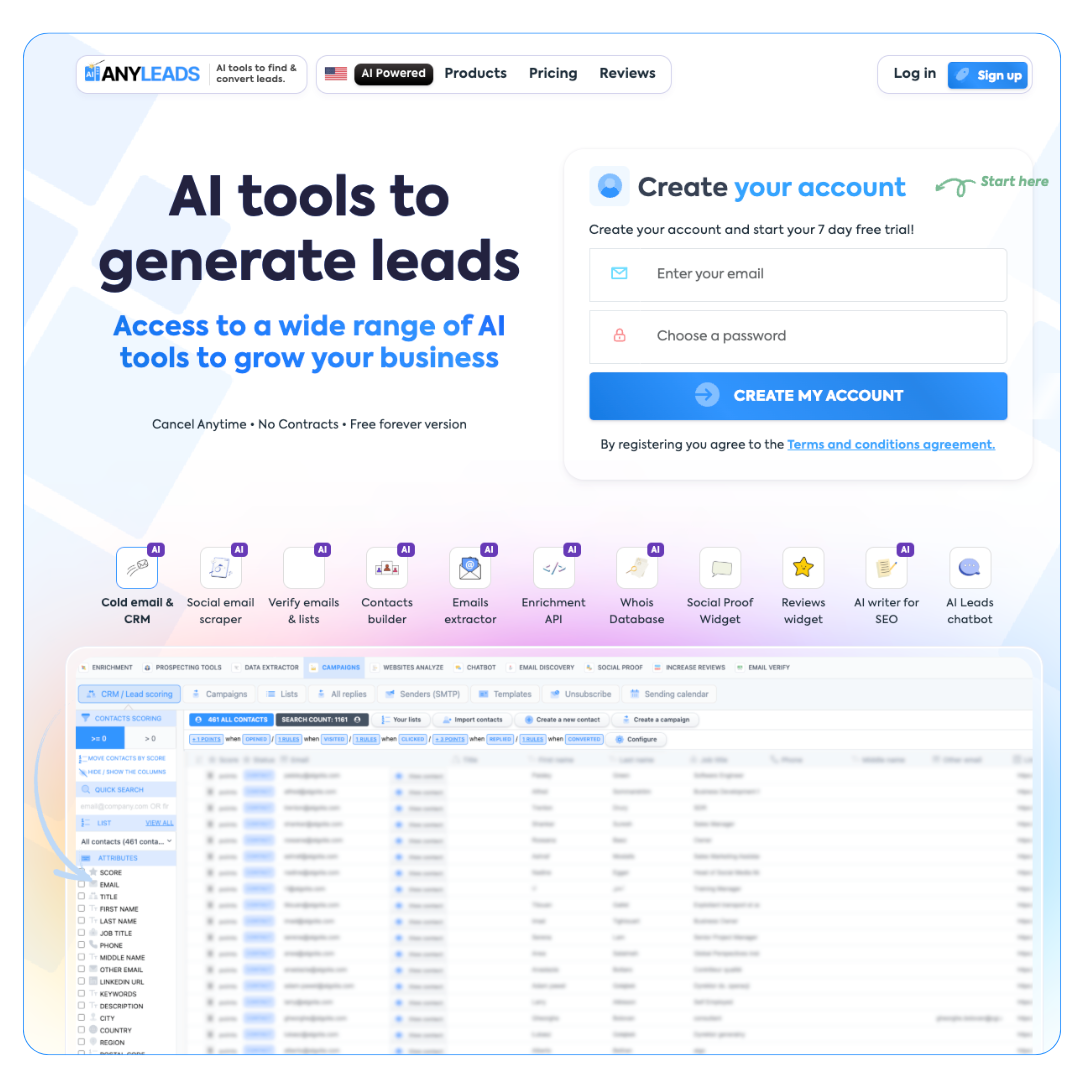 LIMITED SPOTS
All plans are 30% OFF for the first month! with the code WELCOME303
LIMITED SPOTS
All plans are 30% OFF for the first month! with the code WELCOME303

 LIMITED SPOTS
All plans are 30% OFF for the first month! with the code WELCOME303
LIMITED SPOTS
All plans are 30% OFF for the first month! with the code WELCOME303


Picture this: your sales rep calls a prospect at 3 PM on a Tuesday. They fumble through a generic pitch, not knowing the company just announced layoffs last week. The call ends in awkward silence. Sound familiar?
This isn't just embarrassing—it's expensive. Every cold call without context is basically throwing money out the window. But what if your team knew exactly who they were calling, when to reach out, and what pain points to address?
That's where lead enrichment comes in. And in 2025, it's not just nice to have—it's make-or-break.
Lead enrichment is like having a private investigator for every prospect. But instead of following people around with a camera, you're gathering digital breadcrumbs that tell you everything you need to know.
Here's what we're talking about: job titles, company size, recent funding rounds, tech stack, social media activity, hiring patterns. Even seemingly random stuff like office locations or recent press mentions. All of this gets layered onto your basic contact info—name, email, phone number.
The magic happens when you connect the dots. That "Director of Operations" title suddenly means something when you know they're at a 50-person SaaS company that just raised Series A funding. Now you're not just making a call—you're solving a problem they probably didn't even know they had.
What's wild is how many teams skip this step entirely. They'll spend thousands on lead generation, then hand over a spreadsheet with names and emails to their reps. It's like buying a Ferrari and only using first gear.
Remember when your biggest worry was getting past the gatekeeper? Those days are over. Now the real challenge is cutting through the noise in someone's inbox.
Generic outreach is dead. I'm talking about those "Hope this email finds you well" messages that make prospects want to set their computer on fire. With enriched data, you can craft messages that feel like they were written by someone who actually knows their business.
Instead of: "Hi John, I'd love to chat about how our software can help your company."
Try this: "Hi John, noticed DataCorp just opened a Seattle office—congrats on the expansion! We've helped three other fintech companies manage multi-location compliance. Quick question: how are you handling the regulatory differences between states right now?"
See the difference? One sounds like a bot. The other sounds like a human who's been paying attention.
The best part? This approach doesn't just get better response rates (though it does—we're talking 3-4x higher than generic outreach). It actually starts the relationship on the right foot. Your prospect thinks, "Finally, someone who gets it."


Here's something that might sting: your competition is already doing this. While you're still sending "checking in" emails, they're referencing quarterly earnings calls and recent product launches.
Basic contact info tells you who to call. Enriched data tells you why they'd want to talk to you right now. There's a massive difference between knowing someone's email address and knowing they just posted a job listing for a VP of Sales—which probably means they're scaling fast and need tools to support that growth.
Think about it from the prospect's perspective. They get 50+ sales emails a week. Most of them could have been sent to literally anyone. But when someone mentions their recent TechCrunch feature or asks about their expansion into European markets... that's when they stop and read.
The window for generic outreach is closing fast. Buyers expect personalization now. Not just "Hi [FIRST NAME]" personalization—real, thoughtful messages that show you understand their world.
The obvious stuff—company size, industry, job title—that's kindergarten-level enrichment. The teams crushing their quotas are digging deeper.
Recent hiring activity is pure gold. When a company suddenly posts 10 engineering jobs, they're about to scale fast. Perfect time to pitch developer tools, project management software, or team communication platforms.
Funding announcements? Even better. Series A companies need help with everything from HR systems to security compliance. Growth equity rounds usually mean it's time to professionalize operations.
But here's where it gets really interesting: behavioral signals. Website visitors who spent 10 minutes on your pricing page. People who downloaded three different whitepapers. LinkedIn activity that suggests they're researching solutions in your category.
Some teams even track trigger events—executive changes, office relocations, new product launches. Each one creates a moment when the status quo gets questioned. That's your opening.
The key is connecting these signals to business needs. A new CMO doesn't just mean someone changed jobs. It means the company's probably reviewing their entire marketing stack.
Most companies think they need some massive, expensive platform to get started. Wrong move. You can build a solid enrichment process with tools you probably already have.
Start with your CRM. Most modern systems have basic enrichment features built in—they'll pull company info from public databases automatically. Turn that on first.
Next, set up Google Alerts for your target accounts. Sounds old school, but it works. You'll get notifications when prospects get mentioned in the news, announce new funding, or publish thought leadership content. All perfect conversation starters.
LinkedIn Sales Navigator is obvious but underused. Most reps connect and pitch immediately. Smart ones use it to monitor job changes, company updates, and shared connections. The intelligence gathering comes before the outreach.
For the slightly more advanced approach, tools like ZoomInfo, Apollo, or Clearbit can automate a lot of this. They'll take your basic lead list and add dozens of data points automatically. Worth the investment once you're seeing results from manual enrichment.
The trick isn't having the fanciest tools—it's using the data you collect. Set up a system where enrichment happens before outreach, not after. Your reps shouldn't be googling prospects while they're on the phone.


Here's where most teams mess up: they collect tons of data, then ignore half of it. Your CRM becomes a digital hoarder's paradise—stuffed with information nobody uses.
The other extreme is paralysis by analysis. Some reps spend so much time researching that they never actually reach out. Perfect is the enemy of done, especially in sales.
Then there's the creepy factor. Yes, you can find out where someone went to college, their hobbies, even their pet's name. That doesn't mean you should mention all of it in your first email. There's a fine line between personalized and stalkerish.
Data accuracy is huge too. Nothing kills credibility faster than congratulating someone on a promotion they got six months ago, or referencing a company they left last year. If you're going to use enriched data, make sure it's current.
The biggest mistake? Treating enrichment like a one-time thing. Companies change, people change roles, market conditions shift. Your data needs to evolve with your prospects, not gather dust in some spreadsheet.
One thing we've noticed working with design teams at companies like Superside—the most successful sales operations constantly refresh their prospect intelligence, treating data like a living, breathing resource rather than a static database.
This is where things get really interesting. We're moving toward a world where sales reps know about problems before prospects do.
Imagine getting an alert that your target account just hired 20 new customer service reps. That probably means their current system is overwhelmed. Perfect time to pitch your customer success platform—before they even realize they need one.
Or picture this: AI analyzing public earnings calls, identifying subtle language patterns that suggest budget pressure. Your pricing conversation suddenly becomes very different when you know they're looking to cut costs.
The teams who master this approach won't just have better conversion rates—they'll become trusted advisors instead of pushy salespeople. When you consistently bring insights prospects haven't considered, you stop competing on price and start competing on value.
But here's the thing—this only works if you actually use the data to help people, not manipulate them. The goal isn't to become better at tricking prospects into buying. It's about understanding their world well enough to solve real problems.
So here's my challenge: stop treating leads like numbers on a spreadsheet. Start treating them like complex humans with real businesses, genuine challenges, and specific moments when they're ready to change.
The question isn't whether lead enrichment works—it's whether you're willing to put in the effort to do it right.